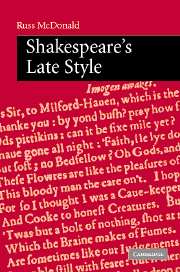6 - Style and the making of meaning
Published online by Cambridge University Press: 22 September 2009
Summary
Style is, in its roots, the language of instinct, and its workings are by nature no less real than the rational purposes of positivist reality.
Richard LanhamThis final chapter is devoted to answering the following question: how does a detailed acquaintance with the technical features of Shakespeare's late style help us to comprehend the plays, both collectively and individually? If the stylistic analysis developed in the foregoing chapters is to amount to more than a dry accounting of poetic devices, metrical eccentricities, and sentence shapes, then it ought to elucidate those larger topics of meaning and purpose with which criticism, despite the quantity of work devoted to these texts, has continued to struggle. Therefore this chapter necessarily reviews some well-known critical themes: for example, the reader will find discussion of theatrical self-consciousness, the relation of art and nature, the pain of loss and joy of reconciliation. Although much of this material will be familiar, most treatments of those ideas neglect the contribution of the poetry. My aim is to demonstrate how the distinctive late verse joins with the dramatic mode to articulate and modify these themes. I hope that we have now acquired a more comprehensive understanding of these plays' “formal grammar and poetic idiom,” to repeat the quotation from Kiernan Ryan cited in the Introduction, and that this understanding might give us a better chance at learning “how to read them.”
- Type
- Chapter
- Information
- Shakespeare's Late Style , pp. 219 - 254Publisher: Cambridge University PressPrint publication year: 2006



